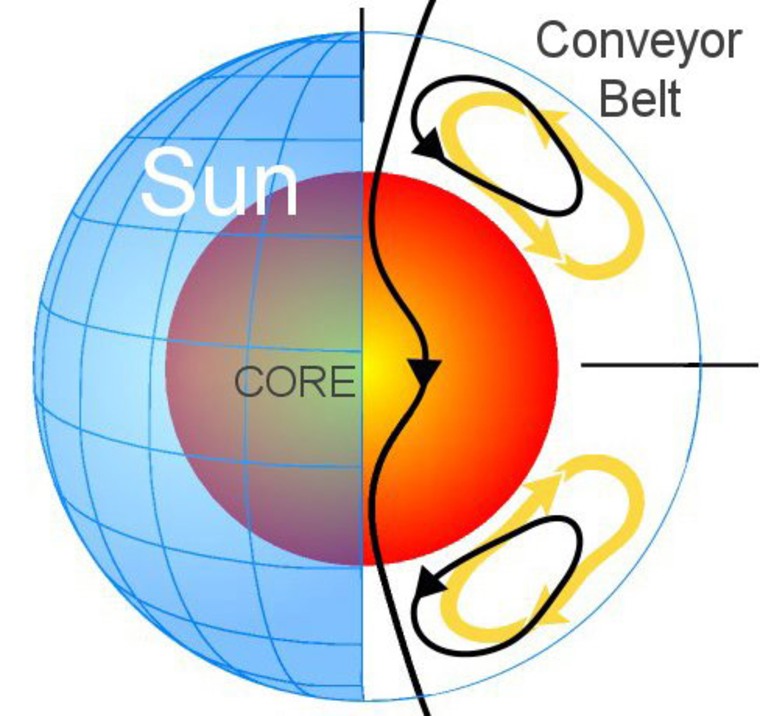A new study reports that the top of the gigantic conveyor belt of plasma moving inside the sun has been running at record-high speeds for the past five years.
The phenomenon might be the reason why the sun has continued to have so few sunspots recently when it should be ramping up the production of these surface-blotching storms.
"I believe this could explain the unusually deep solar minimum we've been experiencing," said David Hathaway, a solar physicist at NASA and co-author of a new study describing the findings, in a NASA statement. "The high speed of the conveyor belt challenges existing models of the solar cycle and it has forced us back to the drawing board for new ideas."
The so-called Great Conveyor Belt is a massive circulating current of hot plasma within the sun. It has two branches, north and south, each taking about 40 years to complete one circuit. Researchers believe the turning of the belt controls the sunspot cycle.
Hathaway has been monitoring the conveyor belt using data from the Solar and Heliospheric Observatory (SOHO). The top of the belt skims the surface of the sun, sweeping up knots of solar magnetism and carrying them toward the poles.
SOHO is able to track those knots — Hathaway called them "magnetic elements" — and thus reveal the speed of the underlying flow.
"It's a little like measuring the speed of a river on Earth by clocking the leaves and twigs floating downstream," Hathaway explained.
SOHO's dataset extends all the way back to 1996 and spans a complete solar cycle.
Last year, Lisa Rightmire, a student of Hathaway from the University of Memphis, spent the entire summer measuring magnetic elements. When she plotted their speeds versus time, she noticed how fast the conveyor belt has been going.
A note about "fast": The Great Conveyor Belt is one of the biggest things in the whole solar system and by human standards it moves with massive slowness. "Fast" in this context means 20 to 30 miles per hour. A good bicyclist could easily keep up.
Shocking speed
The speed-up was surprising on two levels.
First, it coincided with the deepest solar minimum in nearly 100 years, contradicting models that say a fast-moving belt should boost sunspot production.
The basic idea is that the belt sweeps up magnetic fields from the sun's surface and drags them down to the sun's inner dynamo. There the fields are amplified to form the underpinnings of new sunspots. A fast-moving belt should accelerate this process.
So where have all the sunspots been? The solar minimum of 2008-2009 was unusually deep and now the sun appears to be on the verge of a weak solar cycle.
Instead of boosting sunspots, Hathaway believes that a fast-moving Conveyor Belt can instead suppress them "by counteracting magnetic diffusion at the sun's equator."
The second surprise has to do with the bottom of the Conveyor Belt.
SOHO can only clock the motions of the visible top layer. The bottom is hidden by about 200,000 kilometers of overlying plasma. Nevertheless, an estimate of its speed can be made by tracking sunspots.
"Sunspots are supposedly rooted to the bottom of the belt," said Hathaway. "So the motion of sunspots tells us how fast the belt is moving down there."
He's done that — plotted sunspot speeds versus time since 1996 — and the results don't make sense. "While the top of the conveyor belt has been moving at record-high speed, the bottom seems to be moving at record-low speed. Another contradiction."
Could it be that sunspots are not rooted to the bottom of the Conveyor Belt, after all? "That's one possibility" he noted. "Sunspots could be moving because of dynamo waves or some other phenomenon not directly linked to the belt."
Let's go deeper
What researchers really need is a good look deep inside the sun. NASA's Solar Dynamics Observatory, launched in February 2010, will provide that when its instruments come online later this year.
SDO is able to map the sun's interior using a technique called helioseismology. SOHO can do the same thing, but not well enough to trace the Great Conveyor Belt all the way around. SDO's advanced sensors might reveal the complete circuit, which "could be the missing piece we need to forecast the whole solar cycle," said Hathaway.
The research was published in the March 12 issue of Science.
